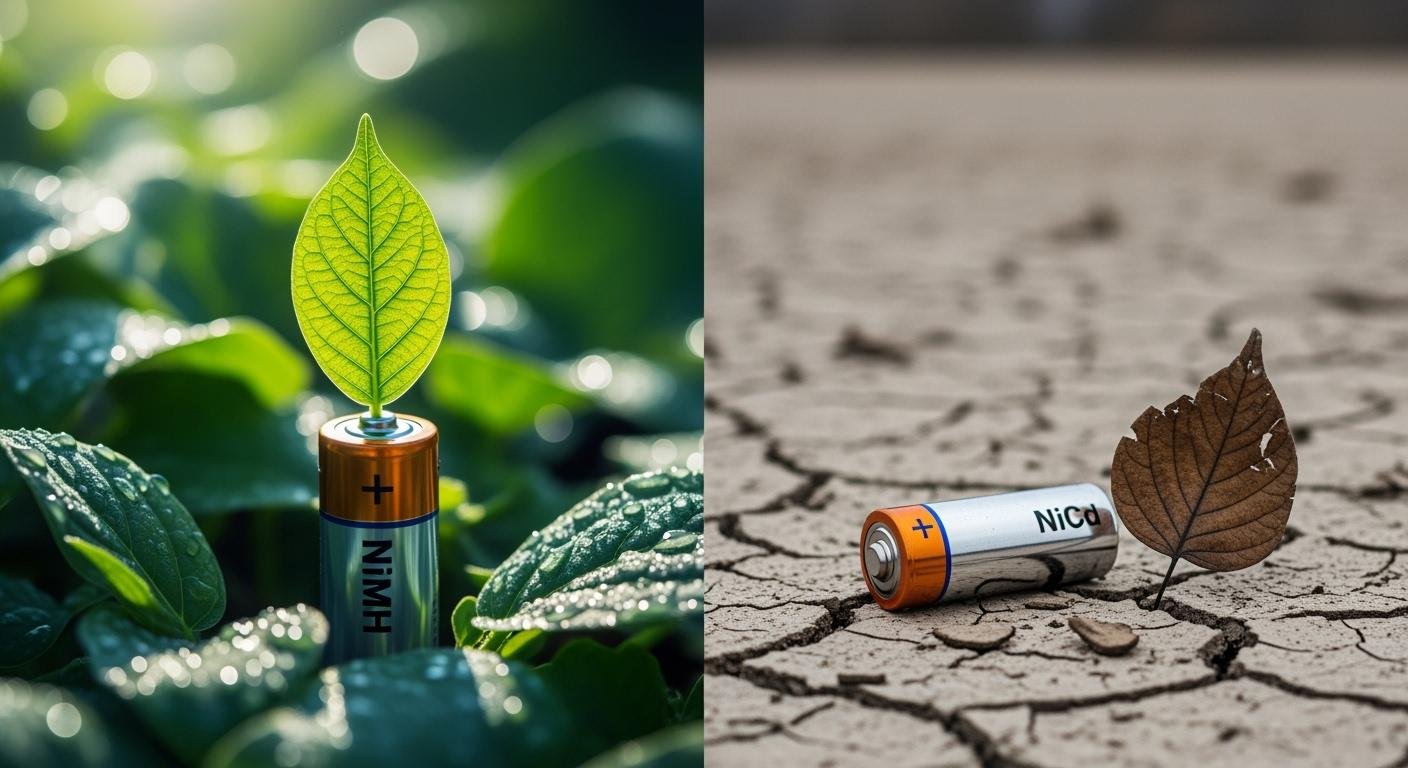
When comparing the NiCd vs NiMH battery, the NiMH battery is clearly better for the environment. The key differences in their environmental impact are stark, making the NiCd vs NiMH battery debate an easy one for eco-conscious users. NiCd batteries contain toxic cadmium, making every NiCd battery a risk. This is why NiMH batteries are a safer rechargeable battery. The NiMH battery is a superior rechargeable choice. NiMH batteries are a better battery.
Chemistry Alert ⚠️
- NiCd: All NiCd batteries use cadmium. The problem with NiCd is this metal. NiCd batteries are a concern, and NiCd is a regulated substance. These NiCd batteries require careful handling.
- NiMH: All NiMH batteries are cadmium-free. The NiMH battery is a great example of safer rechargeable batteries. NiMH is the clear winner. NiMH is a modern chemistry.
The Environmental Dangers of NiCd Batteries

The central issue in the NiCd vs NiMH battery debate is the chemistry of NiCd batteries. Every NiCd battery contains cadmium, a highly toxic heavy metal. This substance creates significant environmental and health risks, making the disposal of NiCd batteries a serious concern. Understanding these dangers highlights the profound environmental impact of this older rechargeable battery technology.
The Problem with Cadmium Toxicity
Cadmium is not just a minor pollutant; it is a dangerous substance with far-reaching consequences. When people improperly discard NiCd batteries, the battery casings can break down in landfills. This process releases toxic cadmium directly into the environment.
Landfill Contamination Alert ☣️ Research shows that cadmium from electronic waste pollutes the areas around landfills.
- Scientists have found high levels of cadmium in groundwater near landfills that accept this type of waste.
- The toxic cadmium harms the helpful microbes that break down organic materials, slowing the entire waste stabilization process.
- The presence of cadmium also severely inhibits the activity of microorganisms needed for a healthy landfill ecosystem.
The danger extends beyond the soil and water. Cadmium poses a direct threat to living organisms, with severe safety implications for both wildlife and humans.
- Wildlife Impact: In nature, cadmium poisoning causes serious harm. Studies on white-tailed ptarmigan in the Rocky Mountains found that nearly half of the adult birds had kidney cadmium levels above the toxic threshold. Cadmium toxicity in animals leads to kidney and liver problems, brittle bones, and reduced survival.
- Human Health Risks: Health organizations classify cadmium and its compounds as known human carcinogens. Epidemiologic studies confirm a direct link between cadmium exposure and lung cancer. More recent research suggests associations with cancers of the breast, kidney, and pancreas. The liver and kidneys are especially vulnerable to its toxic effects.
Responsible Battery Disposal Mandates
Governments worldwide recognize the dangers of NiCd batteries. They have created strict regulations to manage their disposal. These rules classify nickel-cadmium batteries as universal or hazardous waste, which means they cannot be thrown in the regular trash. The goal is to prevent environmental contamination from the NiCd chemistry.
In the United States, federal law mandates how to handle these rechargeable batteries.
- The Environmental Protection Agency (EPA) requires that used NiCd batteries be managed as Universal Waste.
- This rule explicitly forbids handlers from disposing of waste NiCd batteries in landfills.
- Instead, the law requires that all NiCd batteries be sent for proper battery recycling.
The European Union has similar strict controls. The EU Battery Directive bans the use of cadmium in most new battery products, though it allows exemptions for critical applications like emergency lighting and medical equipment. The directive also prohibits landfilling or incinerating any NiCd battery and mandates separate collection for all rechargeable batteries.
Ignoring these regulations carries severe penalties. The consequences underscore the importance of responsible disposal.
- Financial Fines: Businesses can face substantial fines, from thousands to millions of dollars, for improper disposal.
- Legal Action: In serious cases, individuals and companies may face criminal charges, which can lead to jail time.
- Reputational Damage: A company’s failure to comply can damage its brand image, leading to a loss of customer trust and revenue.
These strict rules and harsh penalties exist for one reason: the toxic cadmium in NiCd batteries makes them a significant environmental hazard. This fact alone makes the choice in the NiCd vs NiMH battery comparison clear for anyone concerned with environmental protection.
Key Differences in Battery Chemistry
The fundamental key differences between NiCd and NiMH batteries lie in their internal chemistry. Scientists developed nickel-metal hydride (NiMH) technology specifically to create a less toxic alternative to older rechargeable batteries. This change in battery chemistry directly addresses the environmental problems associated with nickel-cadmium (NiCd) batteries. Understanding this chemistry is crucial to the NiCd vs NiMH battery debate.
The Eco-Friendly NiMH Battery Chemistry
The NiMH battery represents a significant step forward in creating safer rechargeable power. The core innovation of the NiMH battery is the replacement of toxic cadmium. Instead, a NiMH battery uses a special hydrogen-absorbing alloy for its negative electrode (anode). This design choice makes NiMH batteries a much more environmentally friendly option.
The materials inside a NiMH battery are significantly less hazardous than those in NiCd batteries.
- Anode (Negative Electrode): A metal hydride alloy that stores hydrogen. This alloy often contains a mix of metals like nickel, cobalt, and rare-earth elements.
- Cathode (Positive Electrode): Nickel hydroxide, the same material used in a NiCd battery.
- Electrolyte: An alkaline solution, typically potassium hydroxide, which facilitates the flow of ions.
A Look Inside a NiMH Battery 🔬 The material composition of a typical NiMH battery shows its non-toxic nature. The metals used are far less dangerous than the cadmium found in NiCd batteries. This makes the NiMH battery easier to handle and recycle.
| Component | Materials | Percentage (%) |
|---|---|---|
| Anode | Hydrogen Absorbing Alloy | 20-40 |
| Cathode | Nickel–Cobalt–Zinc oxide | 15-25 |
| Nickel | 5-15 | |
| Iron | 20-40 | |
| Electrolyte | Potassium Hydroxide | 0-15 |
Because NiMH batteries do not contain cadmium, governments do not classify them as hazardous waste. This makes disposal and recycling simpler and safer. While NiMH batteries do contain rare-earth elements, recycling these materials is beneficial. Using recycled rare-earth elements from spent NiMH batteries has a much lower environmental impact than mining for new ones. This makes the entire lifecycle of NiMH batteries more sustainable. The chemistry of NiMH makes it the clear winner for users seeking a responsible rechargeable battery.
Cadmium in NiCd Chemistry
The chemistry of NiCd batteries is the source of their environmental risk. Every NiCd battery relies on cadmium as a critical component of its electrochemical reaction. The key differences in the NiCd vs NiMH battery comparison stem directly from this toxic metal. The negative electrode (anode) in all NiCd batteries is made of metallic cadmium (Cd).
During discharge, the cadmium metal reacts with the electrolyte. This chemical process generates electrons to power a device. The overall reaction shows how cadmium is essential to the function of NiCd batteries.
Overall Reaction (Discharge):
2NiOOH + Cd + 2H₂O → 2Ni(OH)₂ + Cd(OH)₂
This reaction shows cadmium (Cd) converting into cadmium hydroxide. While this process is contained within the battery casing, any breach or improper disposal releases this toxic element. The presence of cadmium defines the NiCd battery chemistry. This reliance on a known carcinogen is why NiCd technology is outdated and heavily regulated. The non-toxic materials in NiMH batteries offer a modern, safer, and more responsible solution for most rechargeable applications. The choice between NiMH and NiCd is a choice between a hazardous chemistry and a safer one.
NiCd vs NiMH Battery Performance Comparison
Beyond environmental impact, the key differences in the NiCd vs NiMH battery debate include battery performance. A performance comparison reveals distinct advantages for each chemistry in specific situations. The choice between a NiMH battery and a NiCd battery often depends on the device’s power requirements. Understanding this battery performance helps users select the right rechargeable battery for their needs.
Energy Density and Capacity
One of the most significant key differences is energy capacity. NiMH batteries hold much more power than NiCd batteries of the same size. The energy density of a NiMH battery is typically 30–40% higher. This higher capacity means a NiMH battery provides longer runtimes for devices. For example, a digital camera using NiMH batteries can take more pictures on a single charge.
Energy Density at a Glance ⚡ The higher energy density of NiMH batteries is clear when comparing their specifications.
Battery Type Gravimetric Energy Density (Wh/kg) NiMH 60–120 NiCd 45–80
This superior capacity makes NiMH batteries the ideal choice for high-consumption electronics where long-lasting power is essential.
The “Memory Effect” Impact
The “memory effect” is a performance issue that primarily affects NiCd batteries. This problem occurs when a NiCd battery is repeatedly recharged before it is fully empty. Over time, the NiCd battery “remembers” the partial charge level. This process causes tiny crystals to form on the battery’s cadmium plate, which reduces the available power and effective capacity. The battery seems to lose its ability to hold a full charge.
NiMH batteries are largely free from this issue. Users can charge a NiMH battery at any time without worrying about degrading its performance. This makes the NiMH a more convenient and efficient rechargeable option for everyday use, as it does not require a full discharge before every charge.
Discharge Rate and Application Suitability
While NiMH batteries win on capacity, NiCd batteries excel in high-power applications. NiCd batteries have a very low internal resistance. This quality allows them to deliver a strong, consistent current, which is a crucial performance metric for certain devices. They can handle a rapid charge and discharge without damage.
This high-power output makes NiCd the preferred choice for demanding applications.
- Power tools
- Emergency medical equipment
- Two-way radios
In these high-drain applications, the robust performance of NiCd batteries provides the necessary power. A NiMH battery, in contrast, has a more moderate discharge rate, making it less suitable for tools that require sudden bursts of high power. The NiCd vs NiMH battery choice for these applications favors the older NiCd technology for its raw power delivery.
The primary environmental difference is clear: NiMH batteries are safer. They lack the toxic cadmium found in all NiCd batteries. This makes the environmental impact of NiCd a serious concern. While the NiCd offers strong performance, the health and environmental advantages of the NiMH battery are undeniable.
Actionable Tip ♻️ Always choose the NiMH rechargeable battery when possible. Both NiCd and NiMH types require proper battery recycling. Certified programs can recover nearly all cadmium from a NiCd battery, protecting the environmental landscape.
FAQ
Which battery is better for the environment?
NiMH batteries are the superior choice for environmental safety. They do not contain the toxic cadmium found in every NiCd battery. This key difference means NiMH batteries have a much lower environmental impact and are safer to handle.
Can I use NiMH batteries in old power tools?
It depends on the tool’s power requirements. NiCd batteries excel in high-power applications. Some older tools need the strong current a NiCd battery provides. A NiMH battery may not work in all high-drain applications.
Why do NiMH batteries last longer in my camera?
NiMH batteries have a higher energy capacity. This means they store more power than a NiCd battery of the same size. The greater capacity allows devices like cameras to operate for a longer time on a single charge.
Do I have to fully drain a NiMH battery before charging?
No. NiMH batteries are not prone to the “memory effect” that affects NiCd batteries. You can charge a NiMH battery at any time without reducing its long-term capacity or overall performance.

